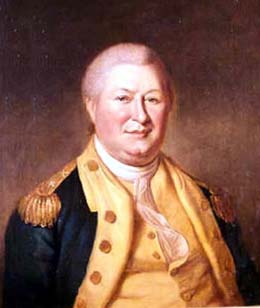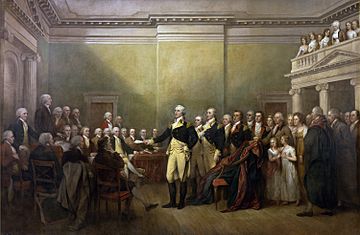William Smallwood facts for kids
Quick facts for kids
William Smallwood
|
|
|---|---|
 |
|
| 4th Governor of Maryland | |
| In office November 26, 1785 – November 24, 1788 |
|
| Preceded by | William Paca |
| Succeeded by | John E. Howard |
| Personal details | |
| Born | 1732 Charles County, Province of Maryland, British America |
| Died | (aged 59–60) Marbury, Maryland, U.S. |
| Resting place | Smallwood State Park |
| Military service | |
| Allegiance | |
| Branch/service | North Carolina Militia |
| Years of service | 1776–1783 (US) |
| Rank | Lieutenant Major general (US) |
| Commands | 1st Maryland Regiment North Carolina Militia (1780) |
| Battles/wars | French and Indian War American Revolutionary War |
William Smallwood (1732 – February 14, 1792) was an important American figure. He was a planter (someone who owned a large farm), a brave soldier, and a smart politician from Charles County, Maryland. He fought in the American Revolutionary War, becoming a high-ranking officer called a major general. Later, he became the fourth Governor of Maryland. He was governor when Maryland agreed to the United States Constitution.
Contents
Early Life and Education
William Smallwood was born in 1732. His parents were Bayne Smallwood and Priscilla Heaberd Smallwood. William had six brothers and sisters. His parents sent him and his brothers to England for their education at a famous school called Eton.
William's family had been in Maryland for a long time. His great-grandfather, James Smallwood, came to America in 1664. James later became a member of the Maryland Assembly, which was like a local government.
Before the American Revolution, William Smallwood was an officer during the French and Indian War. This war was part of a bigger conflict called the Seven Years' War. He was also chosen to be part of the Maryland provincial assembly.
William Smallwood in the American Revolution
When the American Revolutionary War started, William Smallwood became a colonel in 1776. He led a group of soldiers called the 1st Maryland Regiment. This group fought very well in battles in New York and New Jersey.
On December 21, 1777, he led about 1,500 soldiers from Delaware and Maryland. Their job was to stop the British army from taking over Wilmington. They also protected important flour mills.
Smallwood was wounded twice at the Battle of White Plains. Because of his bravery, he was promoted to brigadier general. He continued to serve under General George Washington. His regiment again showed great courage at the Battle of Germantown.

In 1780, Smallwood was part of General Horatio Gates' army. This army was defeated at the Battle of Camden in South Carolina. However, Smallwood's group of soldiers held their ground. This earned him another promotion to major general. Smallwood's reports about the battle and his criticisms of General Gates may have led to investigations by the United States Congress.
Smallwood did not like working under foreign officers. He briefly led the militia (local soldiers) in North Carolina in late 1780 and early 1781. After that, he returned to Maryland and stayed there until the war ended. He left the Continental Army in 1783. That same year, he became a founding member of The Society of the Cincinnati in Maryland.
Serving as Governor of Maryland
In 1784, William Smallwood was chosen to be part of Congress. But before he could start, the Maryland Legislature picked him to be the next Governor of Maryland. He officially became governor on November 26, 1785. He served for three terms, which was the usual amount of time. He left office on November 24, 1788.
Smallwood was governor during a very challenging time for the new country. The first set of rules for the country, called the Articles of Confederation, were not working well. Also, the country was going through a tough economic period.
Despite these problems, Smallwood achieved several important things. He called for a special meeting in Maryland. At this meeting, Maryland agreed to the United States Constitution. This was a big step, even though many people in the state did not want to approve the new Constitution.
Later Years and Legacy
William Smallwood never married. He died in 1792. His home, called Mattawoman, which included his house "the Retreat," went to his sister Eleanor.
Today, you can find historical signs in Calvert, Maryland, that mention General Smallwood. In 1778, he used the "East Nottingham Friends House" as a hospital. Some soldiers who died there were buried in the nearby graveyard.
Smallwood also visited the "Cross Keys Inn," which was built in 1774. This building is now a private home. His restored plantation home, Smallwood's Retreat, is located in Smallwood State Park in Marbury, Maryland. This is also where he is buried. Smallwood Church Road leads from the park to Old Durham Church, where he was a church leader.
Several paintings of William Smallwood exist. One is in the Old Senate Chamber in the Maryland State House in Annapolis, Maryland. He is also shown in a famous painting of George Washington resigning his commission. This painting hangs in the US Capitol Rotunda.
The Maryland Historical Society has a collection of his papers called The William Smallwood Collection.
Honors and Memorials
William Smallwood has been honored in several ways:
- A local group called the Daughters of the American Revolution (DAR) in Baltimore is named the General William Smallwood Chapter. It was started in 1907.
- The General Smallwood Middle School in Indian Head is named after him.
- In Anne Arundel County, Maryland, a coastal fort built in the late 1890s was named Fort Smallwood. This area is now known as Fort Smallwood Park. The road that goes from Fort Smallwood Park through Pasadena, Maryland and into Baltimore City is called Fort Smallwood Road.
Images for kids
-
General George Washington Resigning His Commission by John Trumbull, Capitol Rotunda (commissioned 1817) in the Maryland State House in Annapolis. The portrait features William Smallwood as the third person behind Washington.
-
Gravestone of Gen William Smallwood at his home, Smallwood's Retreat, near Marbury, Maryland






